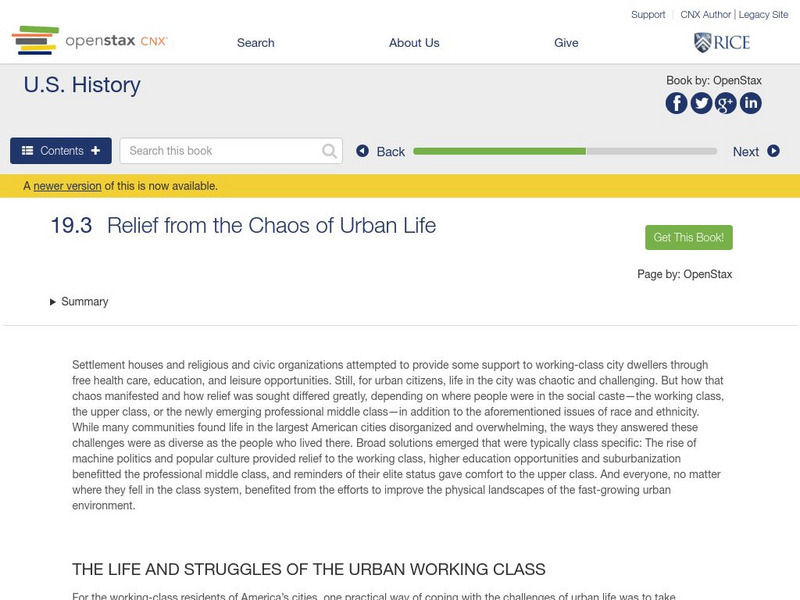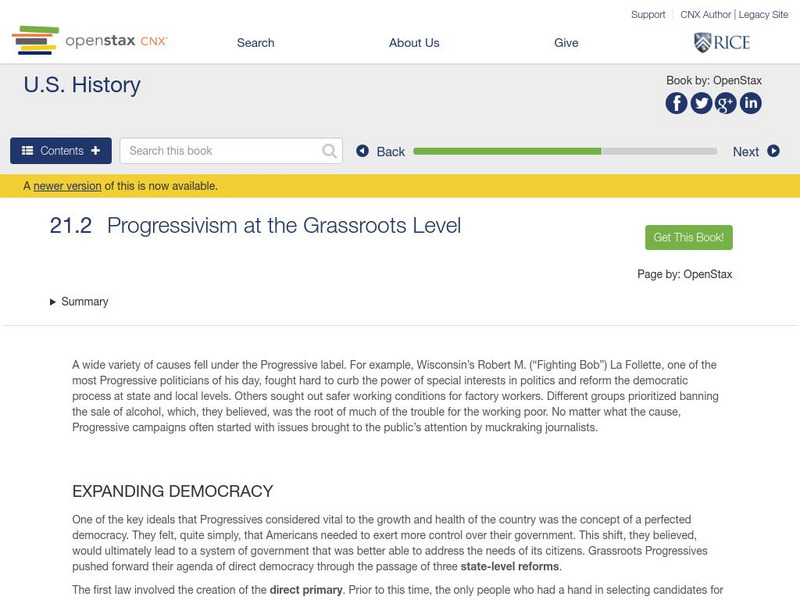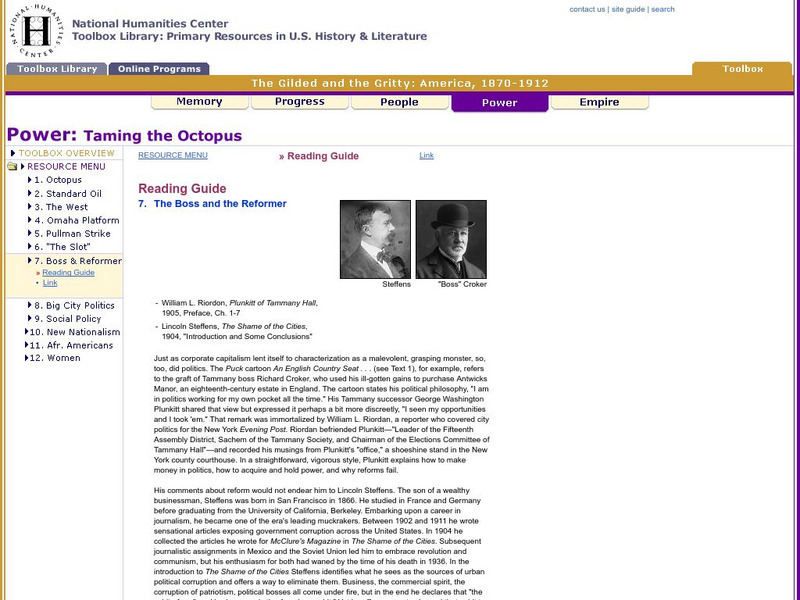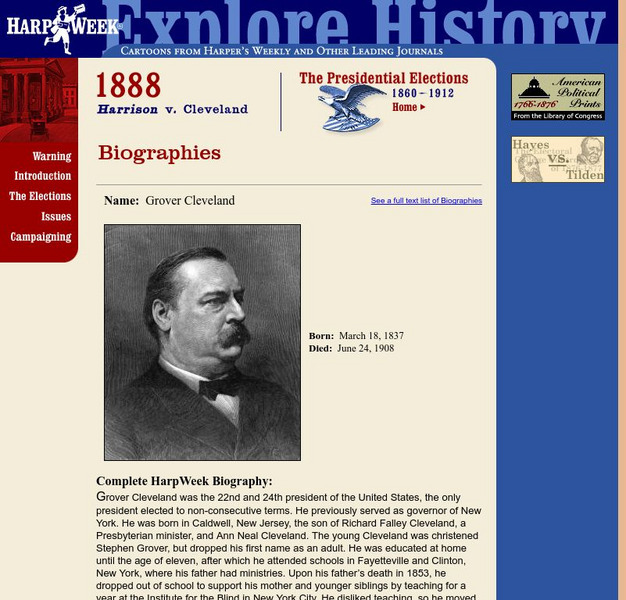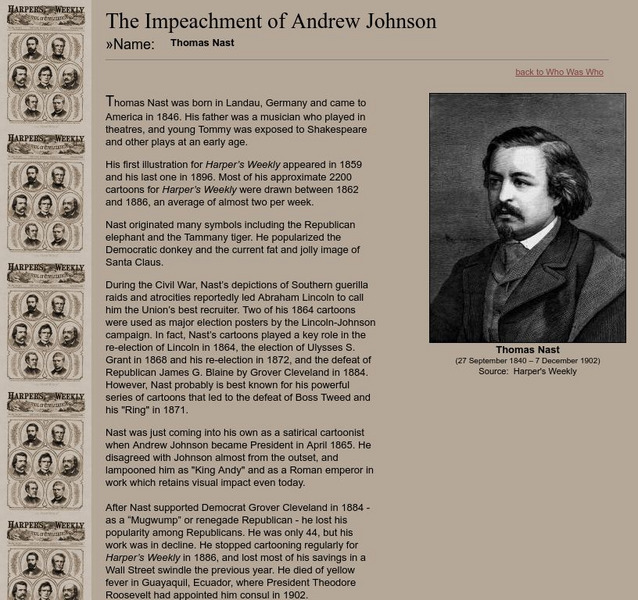Stanford University
Political Bosses Lesson Plan
Students research the political bosses and the political machine in New York City. In this politics lesson, students review the term progressives, political bosses, and political machine. Students study a Tammany cartoon and read...
Social Studies Help Center
Social Studies Help Center: Urban Political Leaders: 1800s Early 1900s
Gives a description of political machines and their three parts that make up the machines. Also discusses what these political machines did and talks of their decline in the 20th century.
OpenStax
Open Stax: Growing Pains of Urbanization: Relief From the Chaos of Urban Life
Learn how different economic classes in urban centers spent their leisure time in the late 19th century. Includes a good discussion of machine politics and the role it played in the lives of the lower classes, as well as its negative...
OpenStax
Open Stax: Progressive Movement 1890 1920: Progressivism at the Grassroots Level
Read about some of the grassroots movements at the heart of Progressivism, and the changes they were pushing for and what they accomplished. Discusses labor issues, including the tragic Triangle Shirtwaist Factory fire. Also discusses...
Scholastic
Scholastic: Tammany Hall
Brief history of Tammany Hall from beginning to the fall of the political machine.
Harp Week
Harp Week: Presidential Elections: 1908 Taft v. Bryan Overview
What a great resource this is. The four-page oveview of the campaign of 1908 begins with a review of the presidency of Theodore Roosevelt. Read about the nomination of William Howard Taft, Roosevelt's acolyte, sure to carry on the...
National Humanities Center
National Humanities Center: Toolbox Library: Power: Taming the Octopus: The Boss and the Reformer
Political boss George Washington Plunkitt explains how big city politics work, and reformer Lincoln Steffens, in an excerpt from The Shame of the Cities, attacks the corruption Plunkitt represents.
Harp Week
Harp Week Explore History: Chester A. Arthur
This biography of Chester A. Arthur concentrates on his time as Collector of the New York Customhouse, and despite his use of the patronage system, when he became president, he became a civil service reformer.
University of Houston
University of Houston: Engines of Our Ingenuity: Thomas Nast
Thomas Nast was the first influential American political cartoonist. Read about his transformation from an illustrator of the Civil War to one who took on Boss Tweed and the corruption of Tammany Hall.
Other
University at Albany: Boss Tweed and the Tammany Hall Machine
A good essay on the political machine of the Gilded Age, the Tweed Ring.
Independence Hall Association
U.s. History: Corruption Runs Wild
Government in the Gilded Age was often corrupt, tainted with money from various groups. Read about the role of political machines in many city governments, in particular Tammany Hall in New York City.
Harp Week
Harp Week: John Kelly
A very interesting biography of John Kelly, a man groomed by Boss Tweed, but one who worked to make New York government respectable after Tweed's death.
Harp Week
Harp Week: The Presidential Elections: Grover Cleveland
A biography from Harp Week's extensive website about presidential elections of Grover Cleveland, outlining his tenure as governor of New York, and his two non-consecutive terms as president.
ClassFlow
Class Flow: Political Machine and Cartoons
[Free Registration/Login Required] This flipchart covers the background of Boss Tweed, Thomas Nast, and the requirements of political cartoons.
Other
Thomas Nast: The Impeachment of Andrew Johnson
Within the article about the President's impeachment is this brief article about cartoonist Thomas Nast, who started as a cartoonist during the Civil War, but saw his greatest influence in the take-down of Boss Tweed and Tammany Hall.
Harp Week
The Presidential Elections 1860 1912: Winfield Scott Hancock
Read a brief biography of Winfield Scott Hancock, Democratic candidate for president in 1880. Read about his career in the military, and discover his fate as candidate.




